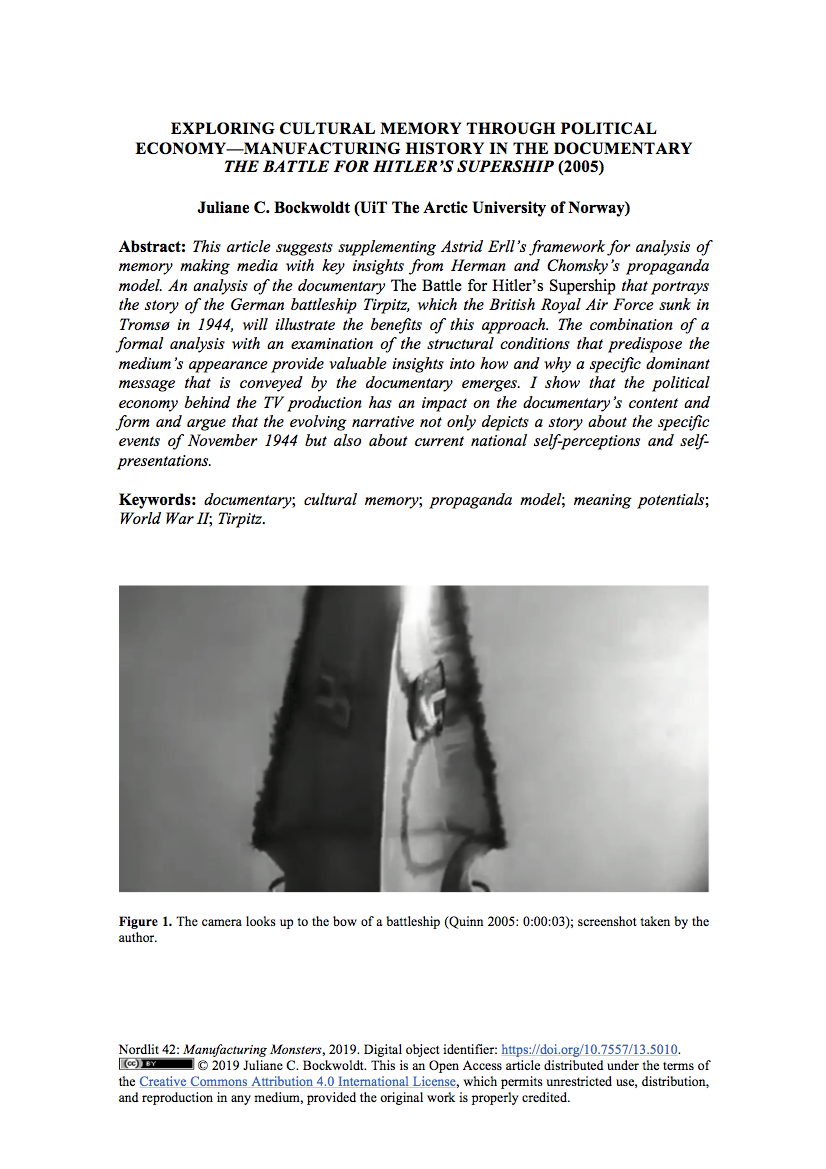Exploring Cultural Memory through Political Economy
Manufacturing History in the Documentary ‘The Battle for Hitler’s Supership’ (2005)
DOI:
https://doi.org/10.7557/13.5010Emneord (Nøkkelord):
dokumentarfilm, kulturelt minne, propagandamodellen, meningspotensialer, andre verdenskrig, Tirpitz (tysk slagskip)Sammendrag
This article suggests supplementing Astrid Erll’s framework for analysis of memory making media with key insights from Herman and Chomsky’s propaganda model. An analysis of the documentary The Battle for Hitler’s Supership that portrays the story of the German battleship Tirpitz, which the British Royal Air Force sunk in Tromsø in 1944, will illustrate the benefits of this approach. The combination of a formal analysis with an examination of the structural conditions that predispose the medium’s appearance provide valuable insights into how and why a specific dominant message that is conveyed by the documentary emerges. I show that the political economy behind the TV production has an impact on the documentary’s content and form and argue that the evolving narrative not only depicts a story about the specific events of November 1944 but also about current national self-perceptions and self-presentations.
Referanser
Alford, Matthew. 2011. “Why Not a Propaganda Model for Hollywood?”, in Screens of Terror: Representations of War and Terrorism in Film and Television Since 9/11, edited by Philip Hammond. Bury St. Edmunds: Arima Publishing, 71–88.
Asmussen, John, and Kjetil Åkra. 2015 [2006]. Tirpitz: Hitler’s Last Battleship. English edition. Bardufoss: Midt-Troms Museum.
Barthes, Roland, and Stephen Heath. 1977. Image, Music, Text. New York: Hill and Wang.
Branigan, Edward. 1992. Narrative Comprehension and Film. London: Routledge.
Brunow, Dagmar. 2015. Remediating Transcultural Memory: Documentary Filmmaking as Archival Intervention. Berlin: Walter de Gruyter. Digital object identifier: https://doi.org/10.1515/9783110436372.
Catterall, Peter. 2013. The Making of Channel 4. London: Routledge. Digital object identifier: https://doi.org/10.4324/9780203763285.
Corner, John. 1999. “British TV Dramadocumentary: Origins and Developments”, in Why Docudrama? Fact-Fiction on Film and TV, edited by Alan Rosenthal. Carbondale/Edwardsville: Southern Illinois University Press.
Der Derian, James. 2009 [2001]. Virtuous War: Mapping the Military–Industrial–Media–Entertainment Network. Expanded, second edition. London: Routledge. Digital object identifier: https://doi.org/10.4324/9780203881538.
Erll, Astrid. 2008. “Literature, Film, and the Mediality of Cultural Memory”, in Cultural Memory Studies: An International and Interdisciplinary Handbook, edited by Astrid Erll and Ansgar Nünning. Berlin: Walter de Gruyter, 389–398. Digital object identifier: https://doi.org/10.1515/9783110207262.
Erll, Astrid, and Stephanie Wodianka. 2008. Film und Kulturelle Erinnerung: Plurimediale Konstellationen. Berlin: Walter de Gruyter.
Evans, Owen. 2010. “Redeeming the Demon? The Legacy of the Stasi in Das Leben der Anderen”, Memory Studies 3:2, 164–177. Digital object identifier: https://doi.org/10.1177/1750698009355678.
Genette, Gérard. 1997. Paratexts: Thresholds of Interpretation. New York: Cambridge University Press. Digital object identifier: https://doi.org/10.1017/CBO9780511549373.
Gibbon, Piers. 2018. “Award-Winning Voiceover”, Piers Gibbon webpage, date unknown. Available online: http://piersgibbon.com/voiceover/ [December 22, 2018].
Godmilow, Jill, and Ann-Louise Shapiro. 1997. “How Real Is the Reality in Documentary Film?”, History and Theory—Studies in the Philosophy of History 36:4, 80–101. Digital object identifier: https://doi.org/10.1111/0018-2656.00032.
Helseth, Tore, and Arnt Maasø. 2008. “Musikk og lyd i film”, in Filmanalytiske tradisjoner, edited by Eva Bakøy and Jo Sondre Moseng. Oslo: Universitetsforlaget, 79–85.
Henckel von Donnersmarck, Florian (dir.). 2006. Das Leben der Anderen. Feature film. Munich/Frankfurt: Buena Vista International Germany.
Herman, Edward S., and Noam Chomsky. 2002 [1988]. Manufacturing Consent: The Political Economy of the Mass Media. Reprint edition with a new introduction. New York: Pantheon Books.
Iversen, Gunnar, and Asbjørn Tiller. 2014. Lydbilder: Mediene og det akustiske. Oslo: Universitetsforlaget.
Jones, Sara. 2012. “Memory on Film”, European Journal of Cultural Studies 16:2, 194–210. Digital object identifier: https://doi.org/10.1177/1367549412467180.
Larsen, Peter. 2013 [2005]. Filmmusikk: Historie, analyse, teori. Second edition. Oslo: Universitetsforlaget.
Marich, Robert. 2013 [2005]. Marketing to Moviegoers: A Handbook of Strategies and Tactics. Third edition. Carbondale: Southern Illinois University Press.
Molden, Berthold. 2016. “Resistant Pasts versus Mnemonic Hegemony: On the Power Relations of Collective Memory”, Memory Studies 9:2, 125–142. Digital object identifier: https://doi.org/10.1177/1750698015596014.
NDR [Norddeutscher Rundfunk] (author unknown). 2005 [1991]. NDR-Staatsvertrag vom 17./18. Dezember 1991, zuletzt geändert mit dem Staatsvertrag zur Änderung des Staatsvertrages über den Norddeutschen Rundfunk (NDR) vom 1./2. Mai 2005. Available online: https://www.ndr.de/der_ndr/unternehmen/staatsvertrag100.pdf [December 22, 2018].
Nichols, Bill. 1991. Representing Reality: Issues and Concepts in Documentary. Bloomington: Indiana University Press.
Nichols, Bill. 2010 [2001]. Introduction to Documentary. Second edition. Bloomington: Indiana University Press.
Plantinga, Carl R. 1997. Rhetoric and Representation in Nonfiction Film. New York: Cambridge University Press.
Pötzsch, Holger. 2012. “Framing Narratives : Opening Sequences in Contemporary American and British War Films”, Media, War & Conflict 5:2, 155–173. Digital object identifier: https://doi.org/10.1177/1750635212440918.
Pötzsch, Holger. 2013. “Ubiquitous Absence: Character Engagement in the Contemporary War Film”, Nordicom Review 34:1, 125–144. Digital object identifier: https://doi.org/10.2478/nor-2013-0047.
Quinn, James (dir.). 2005. The Battle for Hitler’s Supership. Documentary film. London: Tigress Productions/Endemol Shine UK.
Quinn, James. 2013. This Much Is True: 14 Directors on Documentary Filmmaking. London: Bloomsbury Academic.
Rosenstone, Robert A. 2006. History on Film—Film on History. Harlow: Pearson Education.
SIDF [Sheffield International Documentary Festival] (author unknown). 2015. “Quinn, James”, Sheffield Doc/Fest webpage, June 1. Available online: https://www.sheffdocfest.com/buyers/7074 [link defunct as of December 22, 2018].
Sturken, Marita. 2008. “Memory, Consumerism and Media: Reflections on the Emergence of the Field”, Memory Studies 1:1, 73–78. Digital object identifier: https://doi.org/10.1177/1750698007083890.
Taves, Brian. 2001. “The History Channel and the Challenge of Historical Programming”, in Television Histories: Shaping Collective Memory in the Media Age, edited by Gary R. Edgerton and Peter C. Rollins. Lexington: The University Press of Kentucky, 261–281.
Tigress Productions (author unknown). 2018. “Sink the Tirpitz”, Tigress Productions webpage, date unknown. Available online: https://www.tigressproductions.co.uk/productions/sink-the-tirpitz/ [June 5, 2019].









